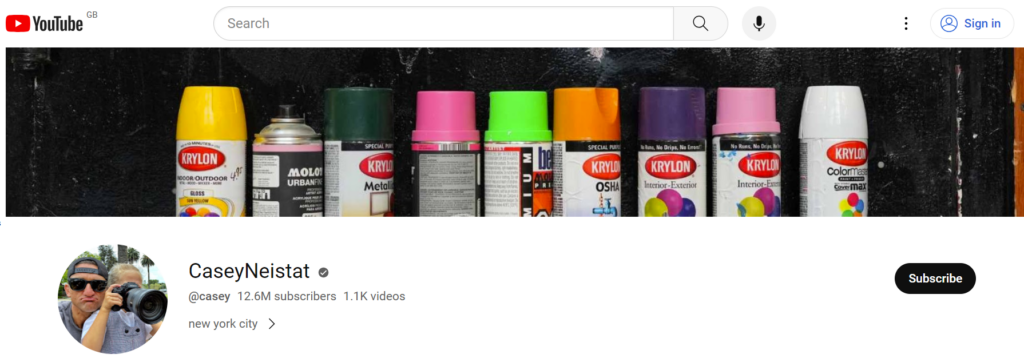Blog vs Vlog: Which is The Better Investment?

When you buy something through one of the links on our site, we may earn an affiliate commission.
What’s the key difference between a blog vs vlog? While the two may seem incredibly similar, some extreme differences are important if you get into one or both content mediums.
To help you avoid failing at one or both, we’ll discuss the critical points of each and clarify the crucial differences between the two.
Contents
- Blog vs Vlog: Which One Is for You?
- Blog vs Vlog Equipment
- Blog vs Vlog Cost To Get Started
- Blog vs Vlog Time Commitments
- Blog vs Vlog Topics
- Blog vs Vlog Platforms
- Blog vs Vlog Monetization Methods
- How Much Can You Make Blogging?
- How Much Can You Make Vlogging?
- Examples of Top Blogs
- Examples of Top Vlogs
- Blog and Vlog Alternatives
- Final Thoughts On Blogging vs Vlogging
Blog vs Vlog: Which One Is for You?
Both blogging and vlogging exist for similar reasons: to provide content that users will find informative, entertaining, or satisfying in one manner or another (and for examples, we've listed lots of great blogs about blogging and vlogging). However, content creation for blogging exists mainly in a written format, whereas vlogging is the video equivalent.
Aside from this core difference, a few other factors make creating content for both mediums different.
What Is Blogging?

Blogs are discussion or information websites with written content posts often displayed in reverse chronological order.
At least, that’s the official definition of the term. Nowadays, the term blog has become a catchall for many websites that regularly publish written content.
Some types of websites most commonly associated with blogging in written form include the business blog of corporate companies as well as personal blogs, but also, in more recent times, the niche blog and the affiliate blog. There is an ongoing debate as to whether blogging is dead, but the reality is the medium has simply evolved.
Pros of Blogging
- Easy to reach a mass audience
- Extensive range of topics to write about
- Many methods of monetization
- Low cost to get started
Cons of Blogging
- Harder to keep people engaged
- Content creation can be time consuming
What Is Vlogging?

Vlogging, as many of you have already guessed, is simply a blog in video format. While that may seem like the primary difference, there are other considerations, such as the type of visual content you can cover and how you engage your audience.
A video blog provides a more informal way to present information on most topics. In many respects, vlogging has replaced the personal blog, with many individuals choosing to create visual content rather than writing articles.
Pros of Vlogging
- Easier to engage viewers
- Multiple methods of monetization
- Better for creating personal brands
- Easier to build trust with the audience
Cons of Vlogging
- More expensive to get started
- Less privacy
Blog vs Vlog Equipment

One of the key differences between blogs and vlogs is the type of equipment used by creators for their online content. While there is significant overlap in that both are using computers and software, there are some core differences in the types of software used and the equipment used for both mediums.
Blogs
The most obvious equipment needed for blogging your written content is a computer with a functioning internet connection. Of note is that internet speeds don’t need to be as great for bloggers as for vloggers due to the heavy uploads.
Aside from a computer, some of the software you will need to start blogging includes:
- Blogging platform
- Word processor (optional)
- Email solution (optional)
- Plugins and integrations (optional)
Aside from the above, there are many other optional pieces of equipment you can use, such as heat mapping software for UX and conversion improvements, a CRM for managing your email marketing efforts (if you do email), and a camera for capturing your photographs.
However, you only *need* a computer, internet connection, and a blogging platform to start.
Vlogs
The list of equipment needed for vloggers (like using the best laptops for YouTubers) is quite a bit more and much more expensive, as you will see below.
You also need a computer and internet connection for vlogging, but the key difference is you'll need the computer, and the internet connection need much higher quality with better processing capabilities. This is especially true if you work with 4k video, which can eat through computer processing.
Equipment that you need for getting started, aside from your computer, includes:
- Camera (either phone or dedicated camera)
- Microphone (for quality audio)
- Video editing software
- Video hosting platform
- Camera and microphone cases (optional)
- Extra camera equipment (optional)
- Lighting (optional)
- Green screen (optional)
Of note is that some of the items marked optional above are highly recommended, such as lighting. If you want to produce quality video content that doesn’t look and sound horrible, there is quite a bit of extra equipment involved.
Blog vs Vlog Cost To Get Started

One of the core differences between blog vs vlog is the start cost. With a vlog, you need a video camera of some kind and, if you aren’t simply recording videos at your computer, some way to capture audio and record on the move.
I’ll break down the cost for you of creating a starter blog and a starter vlog using real numbers and product recommendations. I assume you already have a laptop or computer, as it's the foundation for both mediums.
Blogs
While you need more tools for blogging than you might need to create video content, the upside is these tools are pretty cheap.
For blogging, we’ll assume you will self-host rather than using a platform like Squarespace or Wix. However, if you are not technologically minded and just want to focus on content, these aren’t horrible platforms to get started on. We’ll also assume you will do the writing and design instead of hiring out.
A starter setup for creating a blog might look something like this:
| Hosting | Cloudways = $120 |
| WordPress Theme | Astra = $49 |
| Page Builder | Elementor = $49 |
| Branded Email | Google Workspace = $72 |
| Domain Name | Namecheap = $8.98 |
| First Year Total | $298.98 |
Note: if you want to shoestring things, you can get by without some of the above such as branded email and pro versions of Elementor (or other WordPress page builder of choice) and Astra (or other WordPress themes of choice). There may also be other expenses, such as plugins unique to your needs.
Vlogs
For video blogs, the costs of content creation can add up much more quickly. Aside from needing a camera, you must also contend with audio capture, editing videos, and storage.
If you want your website to host your videos on platforms like YouTube (which I recommend for building an audience and further monetization purposes), you will still have the abovementioned costs.
A starter setup for creating a vlog might look something like this:
| Option A | Option B | |
| Camera | Logitech C920 Webcam = $60.13 | Panasonic Lumix G100 = $697.99 |
| Audio Recording | Yeticaster Bundle = $179 | Comica CVM-VM20 Video Microphone = $119 |
| Editing Videos | Adobe Premiere Pro/Creative Cloud = $659.88 | Adobe Premiere Pro/Creative Cloud = $659.88 |
| Lighting | Godox ML60 = $269 | Godox ML60 = $269 |
| Total | $1,168.01 | $1,745.87 |
Note: This is a minimal selection based on the idea you are hosting on YouTube channels and looking to produce decent-quality videos with good audio. There are many cheaper options for cameras, and you can try to use the built-in microphone, but the results will likely be subpar at best.
There are also many other considerations, such as camera cases, alternative video editing tools, and self-hosted platforms if you want a backup to YouTube videos for your website.
Plus, if you also run a blog (which I recommend), that cost should also be factored in.
The moral of the story is that vlogging can go from zero to a hundred quickly regarding costs.
Blog vs Vlog Time Commitments

Along with cost, each of these two content marketing mediums has its level of commitment in terms of time. In many respects, both mediums can be incredibly time-consuming for content creation, but it’s where that time is spent that makes the difference.
Blogs
With blogging, most of your time will naturally be spent writing and editing articles. There are quite a few sub-tasks, such as sourcing photos and uploading your content for each blog post, but these pale in comparison to how much time you will spend researching and writing high-quality content.
To give you some perspective, creating a high-quality post of 2,500 to 3,000 words can take five to seven hours, including research and outlining time. If it’s a topic you know well and you have all of your research already taken care of, it could be less.
Other tasks, such as uploading the content and styling articles, plus sourcing materials, could take another hour or two, depending on how familiar you are with WordPress. You also need to factor in the time spent promoting your blog, which will likely take up another couple of hours each week.
All said and done; you will likely spend 80% or more of your time writing articles.
Vlogs
The story is quite similar with vlogs, with the difference being where your effort is spent. Recording videos isn’t necessarily the largest consumer of most successful vloggers' day. The real-time eater is the video editing process.
A good rule of thumb is that every minute of video will take between thirty minutes to an hour to edit. Considering that the average vlog on YouTube is around five minutes, this can mean anywhere between two and a half to five hours on average of editing for each video you make.
You also have many of the same tasks as bloggers; you still need to promote your videos and upload your vlog posts. Thankfully, uploading your videos to YouTube will take much less time than creating and formatting a blog post.
Blog vs Vlog Topics
One of the significant differences between blogging and vlogging is the topics you can cover with each medium. In reality, you can cover any topic you want with blogs and vlogs. However, some topics are better suited for visual mediums and some for written formats.
Blogs
The key factor to consider with blogs is that you work almost exclusively with words and potentially some pictures and graphics. You can add videos to your text, but it’s ideal to keep them short to avoid breaking up the flow of the article.
For this reason, blogs are a better option for technical content or more informational topics. While many of the first blogs on the net were personal website-type blogs with people writing about their life, the key thing to remember is this was before video was easily recordable and far too expensive to host with poor streaming speeds.
Some content types that work best in written format include reviews, how-to guides, and listicles. For topics where people want quick answers to questions or to fulfill a specific purpose, blogging is almost always better as it allows for skimming.
Vlogs
Vlogs, on the other hand, are often better for personal videos and entertainment. These can be an excellent medium for highly visual topics such as travel, sports, and lifestyle-type content.
People often tune into vlogs because they can relate to the person. So, for highly compelling individuals who are outgoing and can connect with people naturally in life, vlogging can be a powerful medium to get your message across.
What doesn’t work as well on vlogs is review-type content or how-tos where people want a quick answer to a question. Nothing is more frustrating than constantly rewinding a video to find something you missed or watching five minutes of a video when you could have skimmed an article and answered your question in a few seconds.
Blog vs Vlog Platforms

Another significant difference between blogging and vlogging is the different platforms used for hosting and promoting content. Both mediums have a wide range of platforms that support each unique content type, so it’s important to know your options to decide where to host content.
Blogs
The reality with blogging is that most sites will be hosted on WordPress. Over 40% of websites on the internet are hosted on WordPress. With the low cost of setting up and managing a website, most blogs will be hosted on the platform.
Along with WordPress, some of the most common platforms for blogs to be hosted on include:
- Squarespace
- Weebly
- Wix
- WebFlow
- Medium
- Blogger
- Wordpress.com (managed platform)
- Tumblr
- Web.com
There are a few other platforms that make it easy to host blogs. However, the above represents the core of what most blogs will be hosted on.
Vlogs
Vlogs are similar to blogs in that there are several dedicated video-sharing platforms commonly used by vloggers for hosting videos. At the top of this list is YouTube. It’s the largest video hosting platform in the world, with over 2.6 billion active users.
While YouTube is arguably the most critical platform for vloggers, several other platforms can be used, including:
- Dailymotion
- TikTok
- Vimeo
- Twitch
- DTube
As with blogging, many other smaller and less notable or niche platforms can be used for vlogging. The above, however, represents the core of vlogging platforms.
Many vloggers also choose to self-host their videos and add them to their websites. This is highly recommended in conjunction with YouTube and other platforms as it increases the opportunities to earn money.
Blog vs Vlog Monetization Methods
For bloggers and vloggers looking to transition full-time from just a hobby, monetization is a crucial component. Both blogs and vlogs offer various ways to make money, with each medium lending itself better to specific monetization methods.
Blogs

With blogs as a business model, you typically have more opportunities to monetize if you manage your blog through your website. On many alternative platforms, such as Tumblr or Blogger, the terms of service more heavily regulate what can and can’t be done.
With your platform, you have more control over your advertising and monetization options as you don’t have to abide by a third-party platform's terms of service (except your hosting provider).
That said, some of the options you have for monetizing a blog and earning money as a content creator include:
- Affiliate marketing
- Banner ads
- Paid guest posts
- Paid backlinks
- Email marketing
- PPC advertising
- Paid sponsorships/reviews
There are also options specific to certain types of blogs, such as selling courses, setting up an eCommerce store, selling ebooks, etc. Overall, a high-traffic blog with a dedicated following can generate a substantial income over time, given the right nurturing and matching the audience with the right offers.
Vlogs
Vlogs also have many options for monetization but are often more limited in terms of the types of offers and what types of companies they can promote.
Some of the most common ways for vloggers to monetize their channels include:
- Affiliate marketing
- Paid sponsorships
- In-video advertising
As with blogs, vloggers can promote their products, such as eCommerce stores, books, courses, etc. The key thing to remember is that with most vlogs hosted on third-party platforms such as YouTube, what you can and cannot advertise and how you are allowed to advertise are often more restricted.
How Much Can You Make Blogging?
With blogging, the sky is the limit. That said, a reality check needs to be considered before you start looking at this as a path to fame and fortune.
For starters, how much you can make will largely depend on your blogging niche. Personal bloggers, for instance, who don’t have some type of knowledge or expertise people are willing to pay for likely won’t make much.
The same holds for niches that are generally lower in value. An example of this would be a blogger who writes about sewing vs a blogger who writes about luxury travel. There is much more scope to earn money in the luxury travel market; the monetization potential will likely be much greater.
According to Indeed, the average blogger makes just over $35 thousand each year. However, this is a wildly oversimplified number owing to what I mentioned above. At the end of the day, how much you make is going to come down to these factors:
- Length of time blogging
- Audience size
- Niche or topic of the blog
- Negotiation skills with partnerships/affiliate relationships
Besides that, how much you can make blogging will mainly be a factor in how much time you are willing to put into it. It’s not a get-rich-quick scheme and will take a lot of effort to get off the ground.
How Much Can You Make Vlogging?
Everything mentioned above about bloggers holds equally true for vlogging. Your earning potential from your online content will be a product of how much time you put into your vlog and what topics you are speaking about.
A luxury clothing blogger with high-end sponsorships, for example, will likely have greater earning potential than a vegan blogger who shows people how to cook. The reality is that one simply has more money in the industry than the other.
All of the other factors, including length of time vlogging, audience size, and ability to negotiate good relationships with sponsors, will also impact your ability to earn. Using the above example, a vegan vlogger with over a million followers will make much more than a luxury fashion vlogger with only a few thousand.
One thing to note is that, according to ZipRecruiter, the average vlogger in the United States earns a bit over $75,000 annually. The higher average income is likely due to vlogging being a more in-vogue content medium than blogs.
Examples of Top Blogs
Here are three examples of top blogs across different categories to help better illustrate the difference between blogs and vlogs and provide some ideas for starting your own blog.
1. Gary Vaynerchuk

Love him or hate him, it can’t be denied that Gary Vaynerchuk is one of the most successful content producers in the world.
He’s also a great example of someone who operates multi-channel and is just as well known for his vlogging activities as his blogging. Either way, Gary V, as he’s known, is a solid place to start if you’re looking for what works with blogging.
2. Lifehack

Lifehack has become a prevalent resource for people looking to improve their lives across productivity, focus, diet & nutrition, and many others.
With millions of visitors each month, it’s a fantastic example of how high you can scale a blog when you write about a topic people are passionate about.
3. Nomadic Matt

Nomadic Matt is a popular travel blog founded by Matt Kepnes. The blog has become a go-to source for money-saving travel tips and advice for going off the beaten path.
The blog offers an example of how you can take a hobby or passion and scale it into a highly successful blog that brings in a full-time income.
Examples of Top Vlogs
Like bloggers, you can find wildly successful vloggers in almost every niche imaginable. Here are three examples of popular vlogs to give you a better idea of the medium and provide some inspiration.
1. Casey Neistat

Casey Niestat is an example of the early mover advantage in vlogging. He’s one of the first popular YouTubers, with videos dating back to 2010.
Niestat became popular, documenting his life traveling and performing various stunts in public. His YouTube channel has over 12 million subscribers and counting.
2. Holly Gabrielle

Holly Gabrielle is another top vlogger on YouTube with a channel that has over 400,000 subscribers. She is known for recording her traveling and conversations with strangers in public in man-on-the-street style videos.
3. PewDiePie

PewDiePie is one of the most popular vloggers of all time, with over 100 million subscribers on his YouTube channel.
He started around the same time as Casey Niestat and focuses primarily on recording videos of him playing video games with comedic commentary.
Blog and Vlog Alternatives
In the comparison of a blog vs vlog, it’s critical not to leave out the alternative platforms for getting your message out and making money.
Podcasts
Podcasts are one of the most popular and fastest-growing forms of content around. What’s great about the medium is that it’s highly versatile and perfect for a wide range of topics that otherwise wouldn’t work in written format. Many people also combine videos with their podcasts for dual publication on YouTube (learn about the best podcasts on YouTube here).
Email Newsletters
Email newsletters can still be incredibly effective for communicating with people and promoting products, courses, or ebooks. Some email newsletters operate as only email with no website or, at most, a one-page website serving as a signup form (check out our Carrd review for a decent option).
Learn more about how to start an email list without a website here.
Social Media Platforms
This is a viral medium, with social media platforms such as Instagram and Facebook offering content producers billions of potential viewers looking for consistent and exciting content.
Final Thoughts On Blogging vs Vlogging
By now, you’ve likely figured out that the blog vs vlog comparison isn’t as similar as it would seem on the surface. While there is a lot of overlap between these two forms of online marketing, core differences make the two mediums attractive to different types of content producers and audiences.
The great thing is that the two mediums are not mutually exclusive. You can be both a blogger and a vlogger and be highly successful with both, as in the case of Gary Vaynerchuk. With both mediums, the key is to be consistent with your output and focus on providing your target audience with value. Do that, and you will see solid results with both a blogging business or a vlog.
Want to learn step-by-step how I built my Niche Site Empire up to a full-time income?
Yes! I Love to Learn
Learn How I Built My Niche Site Empire to a Full-time Income
- How to Pick the Right Keywords at the START, and avoid the losers
- How to Scale and Outsource 90% of the Work, Allowing Your Empire to GROW Without You
- How to Build a Site That Gets REAL TRAFFIC FROM GOOGLE (every. single. day.)
- Subscribe to the Niche Pursuits Newsletter delivered with value 3X per week
My top recommendations
















